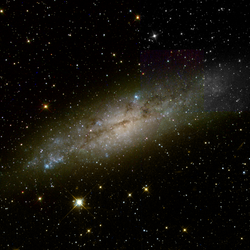NGC 1892
| NGC 1892 | |
|---|---|
 NGC 1892 imaged by the Hubble Space Telescope | |
| Observation data (2000.0 epoch) | |
| Constellation | Dorado |
| Right ascension | 05h 17m 9.0s[1] |
| Declination | −64° 57′ 35″[1] |
| Redshift | 0.004546[1] |
| Helio radial velocity | 1363 km/s[1] |
| Distance | 50,000,000 ly (15,500,000 pc)[2] |
| Apparent magnitude (V) | 12.2[3] |
| Characteristics | |
| Type | Scd[2] |
| Apparent size (V) | 2.9' × 0.8'[3] |
| Other designations | |
| MCG+03-01-030, 4320, 2MASX J05170905-6457354, IRAS 05169-6500, PGC 17042[4] | |
NGC 1892 is a spiral galaxy in the constellation Dorado. It was discovered November 30, 1834 by John Herschel.
A probable supernova of type IIP was photographed by the in 2004,[5] but it was not noticed until Brazilian amateur astronomer Jorge Stockler de Moraes compared the CGS image to one he took in January 2017.[6]
References[]
- ^ a b c d "NED results for object NGC 1892". NASA/IPAC EXTRAGALACTIC DATABASE. Caltech. Retrieved 29 September 2018.
- ^ a b Guillochon, James; Stockler de Moraes, Jorge; Nicholl, Matt; Patnaude, Daniel J; Auchetti, Katie; Barth, Aaron J; Ho, Luis C; Li, Zhao-Yu; Carnegie-Irvine Galaxy Survey (2018). "Serendipitous Discovery of a 14 year old Supernova at 16 Mpc". Research Notes of the AAS. 2 (3): 165. arXiv:1809.00163. Bibcode:2018RNAAS...2c.165G. doi:10.3847/2515-5172/aade89.
- ^ a b Seligman, Courtney. "Celestial Atlas NGC Objects 1850-1899". cseligman.com. Retrieved 29 September 2018.
- ^ "NGC 1892". SIMBAD. Retrieved 29 September 2018.
- ^ "NGC 1892". The Carnegie-Irvine Galaxy Survey (CGS). Retrieved 29 September 2018.
- ^ Kohler, Susanna (2018). "Surprise Discovery of a 14-Year-Old Supernova". Aas Nova Highlights: 4028. Bibcode:2018nova.pres.4028K. Retrieved 29 September 2018.
External links[]
 Media related to NGC 1892 at Wikimedia Commons
Media related to NGC 1892 at Wikimedia Commons
Categories:
- NGC objects
- Dorado (constellation)
- Discoveries by John Herschel
- Spiral galaxies
- Principal Galaxies Catalogue objects
- Spiral galaxy stubs